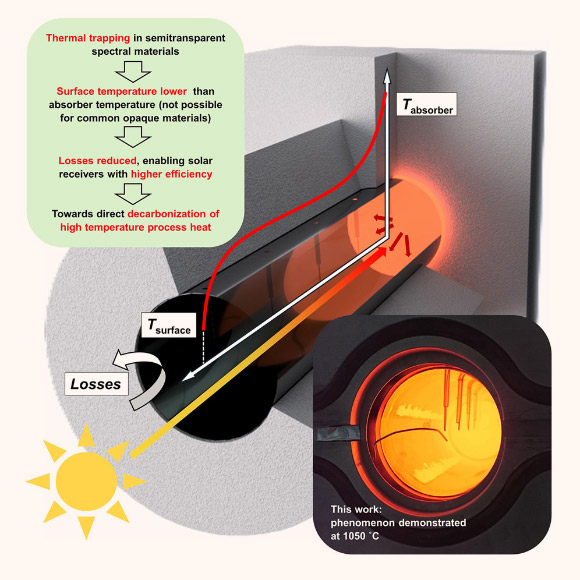With the world focusing on decarbonizing electricity and transportation, abating emissions from industrial process heat remain the elephant in the room. Using solar energy is an attractive alternative, but current solar converters show poor performance and high costs when process temperatures above 1,000 degrees Celsius (1,832 degrees Fahrenheit) are required. In a new work, scientists at ETH Zurich showed how the thermal trap effect, triggerable by exposing common semi-transparent materials (e.g., quartz and water) to solar radiation, can increase the viability of solar receivers by suppressing radiative losses at high temperature. They experimentally demonstrated this effect at the industrial-relevant temperature of 1,050 degrees Celsius (1,922 degrees Fahrenheit).
Casati et al. demonstrated experimentally the solar-trapping effect at temperatures as high as 1,050 degrees Celsius; by using quartz as the volumetric absorption medium, they performed stagnation experiments under concentrated thermal radiation and achieved steady-state temperature differences between the absorber and the outer surface of about 600 degrees Celsius. Image credit: Casati et al., doi: 10.1016/j.device.2024.100399.
“To tackle climate change, we need to decarbonize energy in general,” said Dr. Emiliano Casati, a researcher at ETH Zurich.
“People tend to only think about electricity as energy, but in fact, about half of the energy is used in the form of heat.”
Glass, steel, cement, and ceramics are at the very heart of modern civilization, essential for building everything from car engines to skyscrapers.
However, manufacturing these materials demands temperatures over 1,000 degrees Celsius and relies heavily on burning fossil fuels for heat. These industries account for about 25% of global energy consumption.
Researchers have explored a clean-energy alternative using solar receivers, which concentrate and build heat with thousands of sun-tracking mirrors.
However, this technology has difficulties transferring solar energy efficiently above 1,000 degrees Celsius.
To boost the efficiency of solar receivers, Dr. Casati and his colleagues turned to semitransparent materials such as quartz, which can trap sunlight — a phenomenon called the thermal-trap effect.
The researchers crafted a thermal-trapping device by attaching a synthetic quartz rod to an opaque silicon disk as an energy absorber.
When they exposed the device to an energy flux equivalent to the light coming from 136 suns, the absorber plate reached 1,050 degrees Celsius, whereas the other end of the quartz rod remained at 600 degrees Celsius (1,112 degrees Fahrenheit).
“Previous research has only managed to demonstrate the thermal-trap effect up to 170 degrees Celsius (338 degrees Fahrenheit),” Dr. Casati said.
“Our research showed that solar thermal trapping works not just at low temperatures, but well above 1,000 degrees Celsius. This is crucial to show its potential for real-world industrial applications.”
Using a heat transfer model, the scientists also simulated the quartz’s thermal-trapping efficiency under different conditions.
The model showed that thermal trapping achieves the target temperature at lower concentrations with the same performance, or at higher thermal efficiency for equal concentration.
For example, a state-of-the-art (unshielded) receiver has an efficiency of 40% at 1,200 degrees Celsius (2,192 degrees Fahrenheit), with a concentration of 500 suns.
The receiver shielded with 300 mm of quartz achieves 70% efficiency at the same temperature and concentration.
The unshielded receiver requires at least 1,000 suns of concentration for comparable performance.
The authors are now optimizing the thermal-trapping effect and investigating new applications for the method. So far, their research has been promising.
By exploring other materials, such as different fluids and gases, they were able to reach even higher temperatures.
They also noted that these semitransparent materials’ ability to absorb light or radiation is not limited to solar radiation.
“Energy issue is a cornerstone to the survival of our society,” Dr. Casati said.
“Solar energy is readily available, and the technology is already here.”
“To really motivate industry adoption, we need to demonstrate the economic viability and advantages of this technology at scale.”
The team’s work was published online today in the journal Device.
_____
Emiliano Casati et al. Solar thermal trapping at 1,000°C and above. Device, published online May 15, 2024; doi: 10.1016/j.device.2024.100399
>>> Read full article>>>
Copyright for syndicated content belongs to the linked Source : Breaking Science News – https://www.sci.news/othersciences/energy/solar-thermal-trapping-12938.html
